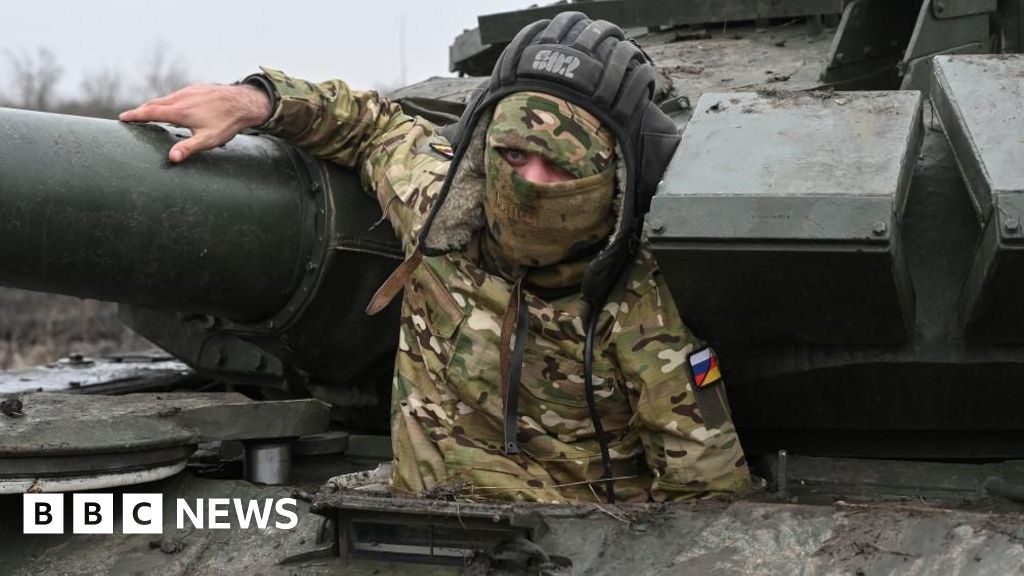As 2024 draws to a close, and winter arrives, Russian forces are continuing to push their Ukrainian opponents back.
In total, Russia has captured and retaken about 2,350 sq km of territory (907 sq miles) in eastern Ukraine and in Russia’s western Kursk region.
But the cost in lives has been horrendous.
Britain’s defence ministry says that in November Russia suffered 45,680 casualties, more than during any month since its full-scale invasion in February 2022.
According to the latest UK Defence Intelligence estimate, Russia lost a daily average of 1,523 men, killed and wounded.
On 28 November, it says, Russia lost more than 2,000 men in a single day, the first time this has happened.
“We’re seeing the Russians grinding out more advances,” one official said, on condition of anonymity. “But at enormous cost.”
Officials said the casualty figures were based on open-source material, sometimes cross-referenced with classified data.
All in all, Russia is estimated to have lost about 125,800 soldiers over the course of its autumn offensives, according to the Washington-based Institute for the Study of War (ISW).
Russia’s “meat-grinder” tactics, the ISW says, mean that Moscow is losing more than 50 soldiers for each square kilometre of captured territory.
Ukraine does not allow publication of its own military casualties, so there are no official estimates covering the last few months.
The Russian defence ministry says more than 38,000 Ukrainian soldiers have been lost (killed and wounded) in Kursk alone – a number that is impossible to verify.
Yuriy Butusov, a well-connected but controversial Ukrainian war correspondent, says that 70,000 Ukrainian soldiers have been killed since February 2022, with another 35,000 missing.
Earlier this week, Ukrainian President Volodymyr Zelensky denied US media reports that as many as 80,000 Ukrainian troops had died, saying it was “much less”.
He did not offer his own figure.
But taken together, the Russian and Ukrainian casualty figures point to the terrifying intensity of fighting going on in Kursk and Ukraine’s eastern regions.
Western officials see no sign of this changing.
“The Russian forces are highly likely to continue to attempt to stretch Ukrainian forces by using mass to overwhelm defensive positions and achieve tactical gains,” one said.
The pace of Russia’s advance has increased in recent weeks (while still nothing like the speed of its rapid advances in the first months of the war), stemmed only by a significant change in the ratio of artillery fire between the two sides.
Where once Russia was able to fire as many as 13 shells for every one Ukraine fired back, the ratio is now around 1.5 to 1.
This dramatic turnaround is partly explained by increased domestic production, as well as successful Ukrainian attacks on depots containing Russian and North Korean ammunition.
But artillery, while important, no longer plays such a decisive role.
“The bad news is that there’s been a massive increase in Russian glide bomb use,” one Western official said, “with devastating effects on the front line.”
Russia’s use of glide bombs – launched from jets flying well inside Russian-controlled airspace – has increased 10-fold over the past year, the official said.
Glide bombs and drones have transformed the conflict, as each side races to innovate.
“We’re at the point where drone warfare made infantry toothless, if not obsolete,” Serhiy, a front line soldier told me via WhatsApp.
As for manpower, both Ukraine and Russia continue to experience difficulties, but for different reasons.
Ukraine has been unwilling to reduce its conscription age below 25, depriving it of all 18- to 24-year-olds – except those who volunteer.
Russia, meanwhile, is still able to replace its losses, although President Vladimir Putin’s reluctance to conduct a fresh round of mobilisation points to a number of domestic considerations.
Soaring inflation, overflowing hospitals and problems with compensation payments to bereaved families are all factors.
In some regions of Russia, bonuses offered to volunteers willing to sign up for the war in Ukraine have risen as high as three million roubles (about £23,500; $30,000).
“I’m not suggesting that the Russian economy is on the brink of collapse,” the official said. “I’m just saying that pressures continue to mount there.”

Leave a Reply